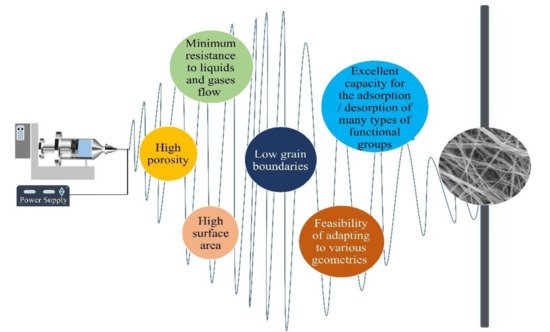1000/1000
Hot
Most Recent

TiO2NFs have important applications in different fields, including catalysis. They are used as a catalyst and a photocatalyst. Most of the TiO2NF-supported catalysts were utilized as photocatalysts in the AB reaction; hence, photocatalysis will be explained in more detail before the discussion of the electrospun photocatalysts.

| Review | Covered Application | Year | Reference |
|---|---|---|---|
| Electrospinning of polymeric nanofibers for drug delivery applications. | Drug delivery | 2014 | [33] |
| Advances in nanofibrous scaffolds for biomedical applications: From electrospinning to self-assembly. | Biomedical. | 2014 | [34] |
| Electrospinning and electrospraying techniques: Potential food-based applications. | Food Industry. | 2014 | [35] |
| Advances in three-dimensional nanofibrous macrostructures via electrospinning. | Tissue engineering. Energy harvesting and Storage, Filtration. |
2014 | [36] |
| Electrospinning for regenerative medicine: a review of the main topics. | Tissue engineering. | 2014 | [37] |
| Hierarchical electrospun nanofibers for energy harvesting, production, and environmental remediation. | Photovoltaics and photocatalysis. Hydrogen energy Harvesting, Fuel cells. |
2014 | [38] |
| Electrospinning of polymer nanofibers for tissue regeneration. | Medical. | 2015 | [39] |
| Fundamentals of electrospinning as a novel delivery vehicle for bioactive compounds in food nanotechnology. | Food technology. | 2015 | [40] |
| A review on electrospinning for membrane fabrication: Challenges and applications. | Water treatment. | 2015 | [41] |
| A comprehensive review summarizing the effect of electrospinning parameters and potential applications of nanofibers in biomedical and biotechnology. | Biomedical and biotechnology. | 2015 | [42] |
| Recent trends in electrospinning of polymer nanofibers and their applications in ultra-thin layer chromatography. | Chromatography. | 2016 | [43] |
| Melt electrospinning today: An opportune time for an emerging polymer process. | Energy, environment, filtration, and separation. Biomedical. |
2016 | [44] |
| A comprehensive review: electrospinning technique for fabrication and surface modification of membranes for water treatment application. | Water treatment. | 2016 | [45] |
| A review of polymer nanofibres by electrospinning and their application in oil-water separation for cleaning up marine oil spills. | Oil–water separation. | 2016 | [46] |
| Electrospinning: A versatile technique for making of 1D growth of nanostructured nanofibers and its applications: An experimental approach. | Energy conversion and storage. Environmental. Biomedical. |
2017 | [47] |
| Electrospinning: A novel nano-encapsulation approach for bioactive compounds. | Encapsulation of different types of bioactive compounds by biopolymer matrixes. | 2017 | [48] |
| Recent advances in multiaxial electrospinning for drug delivery. | Drug delivery. | 2017 | [49] |
| Electrospinning versus microfluidic spinning of functional fibers for biomedical applications. | Tissue engineering. Organ function regeneration. Drug delivery. |
2017 | [50] |
| Fibers for hearts: A critical review on electrospinning for cardiac tissue engineering. | Cardiac tissue engineering. | 2017 | [51] |
| Electrospun Nanofibers Membranes for Effective Air Filtration | Air Filtration. | 2017 | [52] |
| Electrospinning-based (bio)sensors for food and agricultural applications: A review. | Biosensor (Analysis of food/and agricultural products). | 2017 | [53] |
| Electrospinning in solid oxide fuel cells–A review. | Solid oxide fuel cells. | 2017 | [54] |
| Polymer-based composites by electrospinning: Preparation & functionalization with nanocarbons | Tissue engineering Chemical Biosensors Environmental remediation. |
2018 | [55] |
| An overview of electrospun nanofibers and their application in energy storage, sensors, and wearable/flexible electronics. | Wearable/flexible electronics. | 2017 | [56] |
| Recent advances in energy materials by electrospinning. | Energy-related devices. | 2018 | [57] |
| Non-precious nanostructured materials by electrospinning and their applications for oxygen reduction in polymer electrolyte membrane fuel cells. | Fuel cell (Oxygen reduction reaction in a fuel cell). | 2018 | [58] |
| Designing function-oriented artificial nanomaterials and membranes via electrospinning and electrospraying techniques. | Tissue engineering and medicine. Membrane filtration. Lithium battery. |
2018 | [59] |
| Electrospinning: An enabling nanotechnology platform for drug delivery and regenerative medicine. | Biomedical. Regenerative medicine. |
2018 | [60] |
| Emulsion electrospinning: Fundamentals, food applications, and prospects. | Food. | 2018 | [61] |
| Electrospinning and electrospray of bio-based and natural polymers for biomaterials development. | Food Industry. Enzyme immobilization. Tissue engineering. Drug delivery. Wound dressing. |
2018 | [62] |
| Comprehensive review on the electrospinning of starch polymer for biomedical applications. | Biomedical applications. | 2018 | [63] |
| Electrospinning tissue engineering and wound dressing scaffolds from polymer-titanium dioxide nanocomposites. | Tissue engineering. Wound dressing. |
201 | [64] |
| Electrospun nanofiber reinforced composites: a review. | Reinforced composites. | 2018 | [65] |
| ZnO-based ceramic nanofibers: Preparation, properties and applications | ZnO-based CNF applications. | 2019 | [66] |
| A review on electrospinning nanofibers in the field of microwave absorption | Microwave Absorption. | 2020 | [67] |